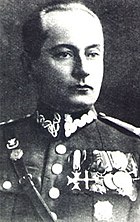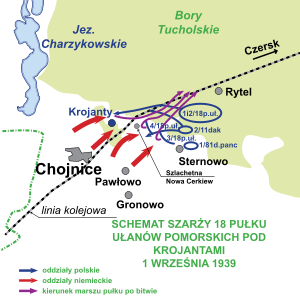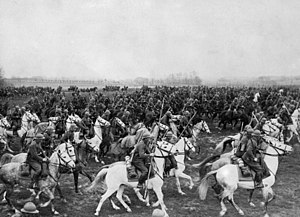Battle at Krojanty
| date | September 1, 1939 |
|---|---|
| place | at Krojanty (Krojanty), Polish Corridor |
| output | draw |
| Parties to the conflict | |
|---|---|
| Commander | |
|
Colonel Kazimierz Mastalerz |
Colonel Hans Gollnick |
| Troop strength | |
| about 600 men | about 800 men |
| losses | |
|
80-100 men |
unknown |
Gdansk - Westerplatte - Tucheler Heide - Krojanten - Mlawa - Radom - Wizna - Bzura - Brześć - Lemberg - Rawa Ruska - Lublin - Kampinos Heath - Warsaw - Szack - Modlin - Hel Peninsula - Kock
The Battle of Krojanty took place on 1 September 1939 by Krojanty ( Krojanten ) north of Chojnice ( Konitz ) in the Polish Corridor place where the Polish 18th Lancers - Regiment on parts of the German 20th Infantry Division met. This battle later gave rise to the myth that Polish cavalry deliberately attacked German tanks with bare sabers.
Development of the situation on September 1st

On the first day of the attack on Poland , the German XIX. Army corps under General of the Panzer Force Heinz Guderian penetrate the Polish Corridor and reach the river Brda ( Brahe ). The motorized 20th Infantry Division ( Lieutenant General Mauritz von Wiktorin ), which belonged to this corps, was given the task of conquering the Konitz railway junction on the way to the Brahe. This place was captured after hard fighting in the early afternoon. The Polish troops , parts of the 9th Infantry Division and the Obrona Narodowa were now slowly, orderly and fighting back to the northeast in front of the 20th Infantry Division (motorized). However, since their units were not motorized, the Germans pushed in faster than the Poles were able to carry out their withdrawal movement. The rearguard came under increasing pressure. In this situation, Colonel Kazimierz Mastalerz , commander of the Polish 18th Uhlan Regiment ( 18th Pułk Ułanów Pomorskich ), was commissioned in the late afternoon to give the retreating infantry units time by means of a local relief attack on the German pursuers.
Course of the battle
Situation in what was then Poland |
Mastalerz had his own 18th Uhlan regiment of the cavalry brigade "Pomorska", the tankettes of the brigade and some infantry units from Konitz. The aim of the limited counterattack was to be a level crossing near the village of Krojanty (about 7 km north of Konitz), which had recently been captured by the German infantry. These troops were a battalion of the 76th Infantry Regiment (motorized) of Colonel Hans Gollnick (about 800 men).
Mastalerz found the German troops in an open area in front of a forest. He then ordered the Rittmeister Eugeniusz Świeściak, the leader of the 1st squadron , to carry out a cavalry attack with his squadron and another squadron (about 250 men out of 600 men). The two remaining squadrons of the regiment remained with the tankettes in their starting positions as reserves.
The attack began at 7:00 p.m. and came as a surprise to the Germans. The 1st squadron galloped through the defensive fire with a bare saber and, in conjunction with the somewhat delayed attacking 2nd squadron, was able to repel the German infantry without major losses. But during the attack, German armored vehicles (probably parts of Reconnaissance Division 20) emerged from the forest around a bend in the road. Using machine guns, they opened fire on Swiesciak's squadrons, who were now in the open ground and the horses could not turn around so quickly. When the Rittmeister fell, Colonel Mastalerz and a few horsemen intervened to save him, and he too fell. The Uhlans fled from the German scout cars , but by then every third Polish horseman was dead or wounded. The attack was not without consequences. In fact, the attack gained enough time for the Polish 1st Rifle Battalion and the "Czersk" Operations Group to retreat to the Brahe. The 20th Motorized Infantry Division did not dare to seriously pursue the Poles that day. But the attack had made an impression on the German soldiers. Heinz Guderian later reported that the commander of the 2nd Infantry Division (motorized) had called him around midnight to inform him that he had been forced to retreat from the Polish cavalry. The commanding general first had to persuade him to hold his position. However, the panic of the first day of the war was soon overcome.
On September 2, General Stanisław Grzmot-Skotnicki (1894–1939), the commander of the "Czersk" operation group, visited the remains of the 18th Uhlan Regiment and symbolically awarded the unit its own Virtuti-Militari order . The regiment took part in the battle in the Tucheler Heide and in the battle of the Bzura for the next few weeks . In the latter, it was almost completely rubbed off.
The myth

The following day, the Italian journalist Indro Montanelli visited the battlefield. When he asked what had happened here, some soldiers replied that Polish cavalry had attacked German tanks here. The journalist embellished this story and published it shortly afterwards. She was grateful for the German propaganda . On September 13th, the magazine Die Wehrmacht reported in the article "This is how our tanks fight" :
- “How much the Poles underestimated the fighting power of our modern weapons was especially evident in the first days of the fight. Irresponsible propaganda persuaded the Polish soldiers that our armored vehicles were better tin dummies. This led to an almost grotesque attack by a Polish Uhlan regiment against some of our tanks. One can imagine the devastating consequences of this attack. "
In fact, the Polish cavalry units were equipped with anti-tank weapons as standard and trained in the correct way to combat tanks. The German reconnaissance tanks had emerged from the forest surprisingly, so that there could be no question of an intended attack by the Polish riders on German tanks. For this, the tankettes that the cavalry brigade owned would have been more suitable.
The topic was taken up again in the propaganda films Campaign in Poland (1940) and Kampfgeschwader Lützow (1941). Since then, this story can be found mostly shortened and unreflected in many popular publications about the Second World War . The Poles, on the other hand, who were shown less favorably by the Soviet side even after the end of the war, emphasize the panic that, according to Guderian, they would have triggered among the Germans, even if only briefly on the first day of the fight. Andrzej Wajda made a film with Lotna on the subject. After the Marshall Islands even presented the topic on a postage stamp in 1989 , the battle was reworked in more detail and shown graphically. Nowadays battle scenes are extensively re-enacted by a Polish group, for internet videos and directly in front of an audience, also with historical or replica vehicles.
literature
- Heinz Guderian : memories of a soldier . Vowinckel, Heidelberg 1951.
- Janusz Piekałkiewicz : Polish campaign. Hitler and Stalin smash the Polish Republic . License issue. Bechtermünz, Augsburg 1997, ISBN 3-86047-907-5 .
- Steven J. Zaloga : The Polish Army 1939-1945 . Osprey, London 1982, ISBN 0-85045-417-4 , p. 8 ( Osprey military - Men-at-Arms 117); Online in Google Book Search
Footnotes
- ↑ Heinz Guderian : memories of a soldier. “The long street was empty. No shot was fired anywhere. So I was all the more astonished when I received a phone call right in front of Zahn and found the men on my staff in the helmet busy setting up an anti-tank gun. When I asked what prompted them to do so, I received the answer that Polish cavalry were on the march and must arrive at any moment. " , 1951, p. 63 ( online in the Google book search)
- ↑ Heinz Guderian : memories of a soldier. “I now sat at the beginning of the regiment that had been pulled out during the night and led it myself to the Kamionka crossing north of Groß-Klonia, in order to set it up on Tuchel from there. The attack of the 2nd (motorized) division was now quickly flowing. The panic of the first day of the war was overcome. The Panzer Reconnaissance Division 3 had reached the Vistula during the night. On the Poledno manor near Schwetz, unfortunately, she had carelessly sensitive ... " , 1951, p. 63 ( online in the Google book search)
- ^ Marshall Islands Republic - History of Second World War. Polish Cavalry and German Tanks (a) 1st issue. Invasion of Poland, 1939.
- ↑ M. Evan Brooks: Military history's most wanted , Brassey's 2002 ( online in Google book search)
- ↑ WWIIdaybyday.com Fall "Weiss" - At 4.45 am German forces launch a large scale attack on Poland from the north and the southwest without a declaration of war. ( Memento from November 15, 2004 in the Internet Archive ).
- ↑ http://histmag.org/grafika/mag007/krojanty3.jpg .
- ↑ http://odkrywca.pl/forum_pics/picsforum18/mapka_krojanty.jpg .
- ↑ sketch .
- ↑ Grupa Re Konstrukcji Historycznej - Reconnaissance Division 7 of the 4th Panzer Division .


